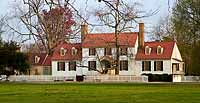Page content
St. George Tucker House
- Home to prominent Williamsburg officer and judge
- Rambling and graceful wooden structure
- Home accommodated Tucker's large and growing family
- First Christmas tree in Williamsburg displayed at house in 1842
- Home restored in 1930 and 1931
- Tucker's descendants lived in house until 1993

Lots purchased from Edmund Randolph in 1788
A lawyer, Revolutionary War militia officer, legal scholar, and judge, St. George Tucker brought three lots on Williamsburg's Palace green from Edmund Randolph for £100 in 1788. The property included the site of William Levingston's theater, the first in America. Bermuda-born but educated at the College of William & Mary, Tucker moved the largest structure, a 1716 building that had been Levingston's home, to its present location on Nicholson Street to face the more-fashionable Market Square.
Home enlarged several times to accommodate Tucker's children
The rambling but graceful wooden building was enlarged several times, partly to accommodate Tucker's children. He was married twice and had nine children and five stepchildren.
Such a large family must have required a sense of humor, which Tucker undoubtedly had, as evidenced by his writing "Garrison Articles to be Observed by the Officers and Privates Stationed at Ft. St. George Tucker in Williamsburg" in order to teach his many children deportment. Tucker himself was "fort comander." One of the 13 articles read, "No Captain or subaltern officer or private shall presume to dance or run about the room at Breakfast or Dinner time."
Tucker constructed Williamsburg's first bathroom
Tucker is better known for editing Blackstone's Commentaries on the Laws of England (Philadelphia, 1803) to put them in an American context. He also is credited with the construction of Williamsburg's first bathroom: he converted his backyard dairy house and installed in it a copper bathtub into which heated water was piped. The tub had a drain, a novelty at the time.
Tucker was a charter member and officer of Williamsburg's "Society for the Promotion of Useful Knowledge." He was an avid gardener, and there appear to be traces of 18th-century gardens in the yard.
First known Christmas tree erected at the house in 1842
William & Mary Professor Charles F.E. Minnigerode, a political refugee from the principality of Hesse-Darmstadt, put up Williamsburg's first recorded Christmas tree at the house in 1842. He was a friend of Tucker's son Nathanial Beverley Tucker. Minnigerode enjoyed Nathanial's children and put up a tree for them in the Tucker parlor in the German Yuletide tradition. A small tree, emblematic of the occasion, now is left each Christmas on the porch.
Tucker's descendants owned home until 1993
The house was restored in 1930 and 1931. Tucker's descendants lived in the house until 1993.
The St. George Tucker House is not a Colonial Williamsburg exhibition site.
Learn More:
